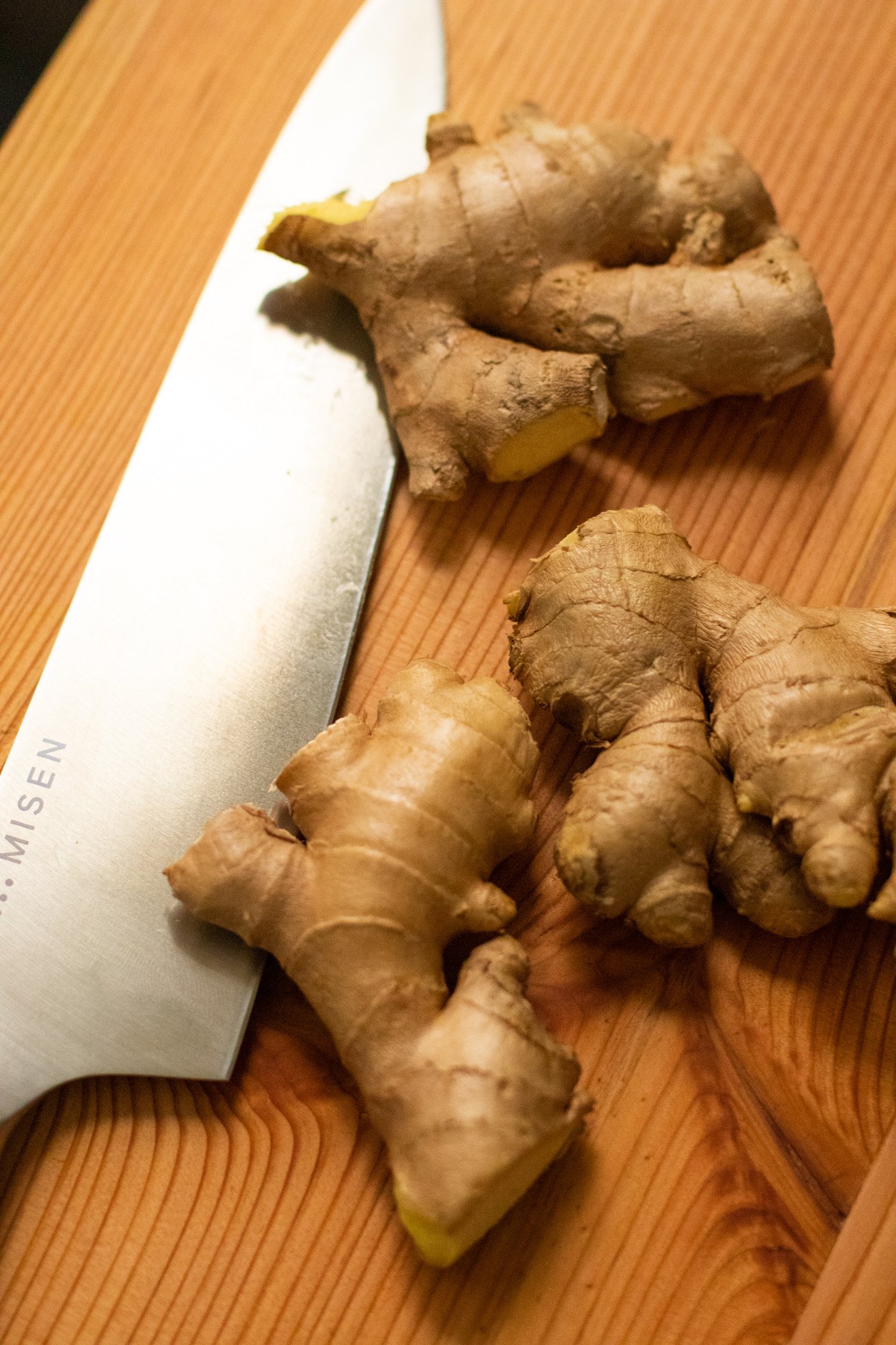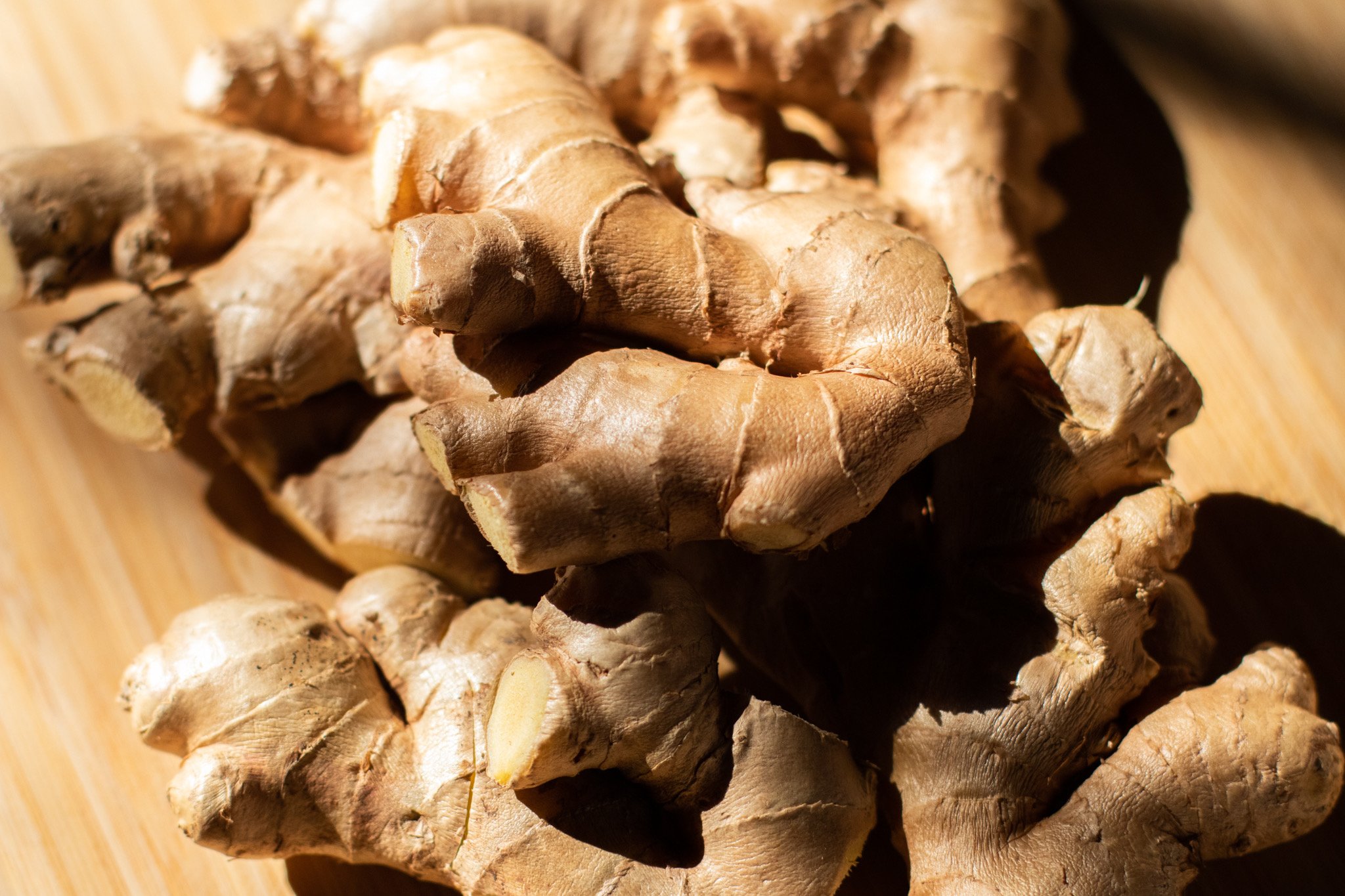Ginger
Spicy, warm, fresh, bright… What other tuber can bring about so many different flavor profiles and act as such a versatile but bold ingredient? Ginger is a truly “iconic” flavor (as the kids say these days), and can be a game changer in your kitchen for adding depth to dishes.
A clump of ginger roots is called a “hand” and there’s something that feels particularly grounded and earthly about that. Unlike so many other things in the grocery store that are polished to look as perfect as possible, I love that ginger hangs out in the produce section in its full, stubby, authentic glory. I was recently thinking about this tropical crop that has become a staple of my cooking, especially in the depths of winter when I’m cooking warm comfort food, and how little I really know about it. Whether it’s a big cup of tea for an upset stomach or a vibrant stir-fry on a Friday night, you may also find yourself turning to ginger quite often in your kitchen. But we rarely talk about it in the context of sustainability.
A bit about ginger…
Ginger is a flowering plant, indigenous to China, and primarily grown in India and many other tropical areas of the world, including Hawaii! Ginger is a member of the Zingiberaceae family, which includes many flowering aromatic perennial herbs with creeping horizontal or tuberous rhizomes (cardamom, galangal and turmeric are also in this family). The ginger root (commonly just called ginger) is harvested and used as a spice, side dish, and natural remedy.. The root, or rhizome, contains oils, the most important of which is gingerol, the main bioactive compound in ginger. It’s responsible for much of ginger’s spicy and aromatic flavors as well as medicinal properties (more on those below!).
While most ginger varieties are from China (larger, yellow) and Japan (smaller, more pungent), Jamaicans are known to have popularized ginger root after it made its way to Europe in the 1500s as part of the spice trade. Today, ginger is available in most grocery stores in the US all year round, supplied continuously by overlapping growing seasons across the globe. In the United States, both Chinese and Japanese varieties of ginger are grown in Hawaii and shipped to the mainland, though the majority of the U.S. supply is imported from China, Brazil, India, Thailand, and Central America.
Beyond being delicious, ginger is well-known for its many health benefits. Ginger has a long history of use in herbalism and traditional medicines around the globe. It’s known to aid digestion, reduce nausea and morning sickness, reduce inflammation associated with arthritis, and help fight flus and colds — when in doubt, ginger never hurts! Ginger is considered a powerhouse of nutrients by many Western and Eastern doctors. It contains a wide range of vitamins – including vitamin C, and B vitamins thiamine, riboflavin and niacin – along with minerals such as iron, calcium, and phosphorus!
Sustainability of ginger production:
Ginger is a relatively sustainable crop and can be integrated into larger farming operations as a high-value crop. It takes 10 months to grow mature ginger, but young ginger can be harvested and sold as a high-value crop (it’s more tender and easy to eat whole) as well, thus providing flexibility in some smaller farming operations.
There are relatively few pests and diseases that dramatically affect ginger production, so pesticide usage for ginger production is relatively low. At the same time, organic ginger is rare and is a high-value commodity. Organic certification and regulation can be difficult and costly across international lines where ginger is grown, so many ginger farmers use minimal chemicals but are not officially certified for sale in the US.
There are currently no major reported labor issues related to ginger production at this time, which is positive, but doesn’t necessarily mean farmworker exploitation is absent on the farms where ginger is grown across the globe. As a product grown mostly in the global south with large import markets in the global north, there is often a lack of transparency along the entire supply chain from farm to plate. However, buying Fair Trade products is one way that consumers can invest in the well-being of those working in ginger production.
Since most ginger is grown in tropical climates, it can be hard to find locally sourced ginger in much of the United States. However, ginger can be grown in northern climates with the use of high tunnels and other season-extending farming practices. When I was living in upstate New York I visited the Finger Lakes Cider House where they were growing ginger through the winter in high tunnels for use in locally produced ginger beer. It was not a large part of their operation, but a small additional source of income. Ginger is such a unique and flavorful crop, that it can serve as this kind of special additional income to diversified operations.
Ways to integrate more sustainability into your ginger consumption:
Make sure you store it correctly: Unpeeled ginger root stored in a plastic bag can last up to two months in your crisper drawer! Not too bad! You can also freeze ginger whole or pre-cut, where it can last up to 6 months and go straight into stir frys or even add a little kick to a smoothie.
Consider buying powdered ginger: While dried ginger can be less potent than fresh, it can be a fantastic spice to have in your pantry for dishes that ask for ginger. Fresh ginger can go bad in your fridge, and is a fresh seasonal product that needs to be shipped around the globe. Buying dried ginger can be an option to have ginger on hand all the time, without risking it going back.
Try growing ginger at home! What’s more local than your countertops? Explore this article to learn more about how to integrate ginger into your kitchen garden.
Ways to use ginger:
Make fresh ginger tea by boiling water and adding sliced peeled ginger, lemon and honey
Add to stir frys and other dishes like like our Thai Coconut Curry
Add to soups like our vegan Carrot Ginger Soup
Sources:


